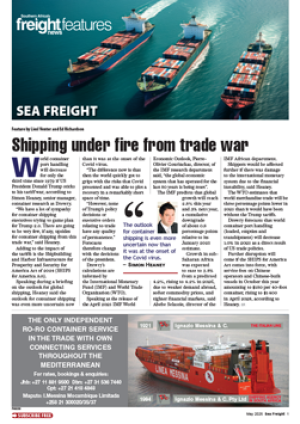The Walvis Bay Corridors
are seen as a model for
successful and sustainable
economic corridor
development across Africa’s
internal borders.
Most corridor initiatives, which
either predate the formation of
the Walvis Bay Corridor Group
(WBCG) in 2000 – following
the official opening of the Trans-
Kalahari Corridor in 1998 and the
Trans-Caprivi Highway in 1999
– are still little more than good
ideas on paper.
Corridors do not just happen
– they need a well-resourced and
funded secretariat backed by
political will and the support of
the private sector.
Their success, which has been
followed closely by FTW, is based
on a public-private partnership
in which government, the port
authorities and the private sector
have been close partners.
The corridors have been driven
by a common vision reinforced
by ongoing investment by the
parastatal port, road and rail
authorities.
Marking the formation of the
WBCG was the completion of
the deepening of Walvis Bay to
12.8 metres and the introduction
of direct calls at Walvis Bay
by Maritime Carrier Shipping
(MACS) and Maersk to and from
Europe. This eliminated the need
and cost of transhipping through
Cape Town.
Having the direct calls put the
Namibian logistics sector into
overdrive. Walvis Bay became
the preferred port for freight into
southern Angola, making the
Trans Cunene corridor the early
success story.
The Trans-Caprivi Highway
became viable in 2004 when a
bridge over the Zambezi River
at Katima Mulilo (Namibia) and
Sesheke (Zambia) was completed.
Since then the WBCG has
worked with the governments
of Namibia, Zambia and the
Democratic Republic of Congo
(DRC) to eliminate bottlenecks
in order to reduce costs by
minimising border delays.
The United Nations Conference
on Trade and Development’s
(Unctad) capacity-building
programme, which was set up
in 2005, identified the Trans-
Caprivi Corridor as a model
corridor in Africa, and supported
the development of the Corridor’s
cluster committee.
The committee is made up
of public and private transport
representatives who meet twice a
year to address corridor issues.
Now, 15 years later, the
government and WBCG are
working at transforming the
transport corridors into full
logistics corridors.
Again the infrastructure is
being created to sustain the
development – new container
berths are being added to the port
of Walvis Bay and work is due to
start on a second “SADC port” in
the bay.
“Namibia has a clear vision
to become a regional leader in
logistics and distribution in
southern Africa. Our current
National Development Plan Four
(NDP4) has identified logistics as
one of the economic priorities, an
area in which Namibia has a clear
comparative advantage. Against
this background, Namibia has
embarked on a transformation
process to establish itself as the
‘Logistics Hub for Southern
Africa,’” says the WBCG on its
website.
This may seem ambitious given
the dominance of the South
African port network in the
region.
But, as Gadzeni Mulenga
pointed out in a 2013 brief
for the African Development
Bank, “Transport corridors can
accomplish much more than
linking point A to point B. With
the economic corridor concept,
Africa’s transport corridors
can not only facilitate regional
integration and trade but can also
reduce poverty, particularly in
catchment regions.
“Planners can achieve this
by carefully coordinating the
social, economic and physical
development of the corridors and
their surroundings.”
And that is what makes the
Walvis Bay Corridors and Namibia
set the benchmark for transborder
corridor development in
Africa.
The initiative has the full
support of government and its
parastatals which are ensuring
that the infrastructure and
enabling environment are in place.
Business is adding its weight
by investing heavily in the region,
as is evident by the large number
of new warehouses going up in
Walvis Bay and Windhoek, and
the entry of new freight, logistics
and clearing companies into the
country.
Established Namibian
companies are also ensuring
that they remain competitive by
ongoing investment in people,
facilities and equipment – a true
partnership between the private
and public sectors.
Like all partnerships it has its
challenges, but there is a reservoir
of goodwill and the structures are
in place to find common ground
in order to reduce the costs of
doing business across borders for
Zambia, Zimbabwe, Botswana, the
DRC – and Gauteng.
CAPTION
The corridors have been driven by a common vision reinforced by
ongoing investment by the parastatal, road and rail authorities –
and of course the Port of Walvis Bay.

